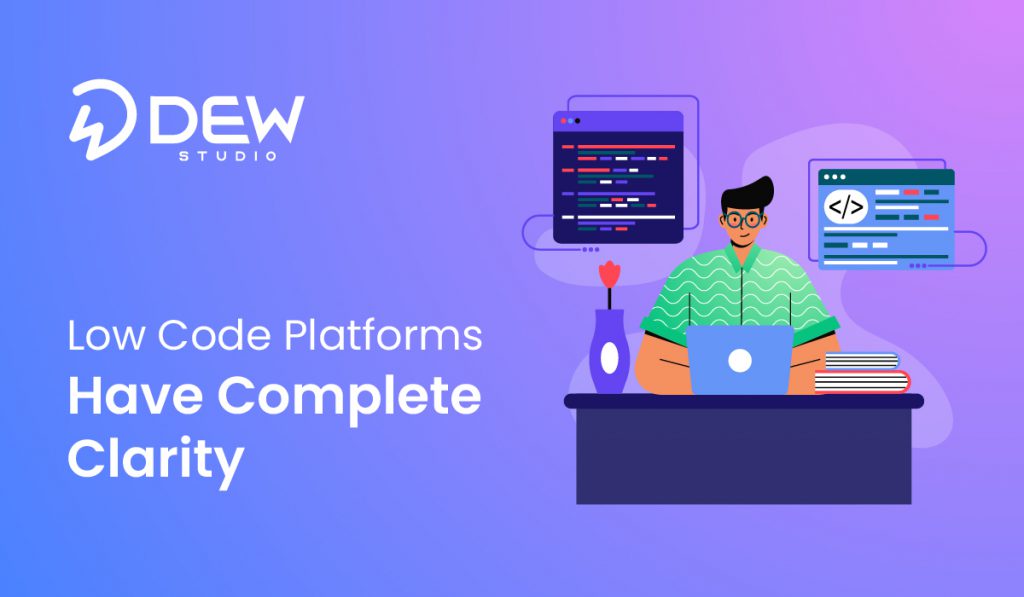Since the COVID-19 pandemic, the demand for web applications has increased more than ever. Since remote operations are on the rise, enterprises are becoming more dependent on applications to handle their business operations and workflows. Businesses that want to create applications, look for innovative strategies to speed up the process. Using a Low Code solution is one of the key ways firms are boosting their capacity to build apps by two times compared to older methods.
Organizations integrate cutting-edge technologies like Low Code software into their existing systems. Many techies and business owners are although, unsure, about the efficacy and the utility of Low Code development.
In this article, we’ll get a deeper insight into the Low Code development platform and figure out how they can be useful for businesses.
What does “Low Code” mean exactly?
With the use of drag-and-drop features like data binding, code generation, query builders, and others, users may quickly design applications using the Low Code app for software development. The front-end creation of app functionalities by programmers or developers enables them to create custom code in the back end, which is a straightforward way to comprehend Low-Level programming. The front end of the application can be swiftly adjusted to meet production needs based on the prototype of the application modules.
Therefore, the Low-Code application is simply an automation tool that uses drag & drop functionality to speed up the app development process. It efficiently automates the process of building apps, fixing errors and seamlessly compiling the code. A Low-code app development platform, which places a strong emphasis on automation, provides a drag-and-drop user interface to further simplify the process of creating applications.
Low code automation platform has roots in rapid app development tools (RAD) from the 1990s and early 2000s as well as a fourth-generation programming language (4GL). As it needs to serve as an application to create software, it is built using a model-driven design and development methodology. The primary goal of creating a Low Code tool was to replace the time-consuming coding tasks with drag-and-drop features to create apps.
Enterprises are increasingly in need of immediate software solutions as technology advances at an exponential rate. Companies are now demanding speedier app production to rapidly meet the changing needs of their clients. The Low-Code automation platform can be helpful to fulfill this requirement. It serves as a means of producing apps quickly and replacing the laborious old coding approach in doing so.
DEW Low Code tool is among the top Low Code platforms that can enhance your company’s capability for developing applications faster.
Increasing Productivity with the Low-Code App
Low Code development solution eliminates the necessity for time-consuming coding operations, freeing up valuable time to promptly concentrate on other crucial responsibilities. Here, we’ve outlined a few of the several ways the Low-Code app can boost productivity in your business to save time and money.
- Reduces App development time
Comparing a Low Code App to traditional coding techniques, app development time can be reduced by up to half the time. Your company’s productivity can grow as a result of the time saved here, which can be applied to other tasks. You can teach new programmers to create highly competent apps so you won’t have to always rely on professional programmers.
DEW is an illustration of a Low-Code platform that has improved and optimised business operations for numerous corporations of various sizes.
- Using visual modelling to create apps
Each step of the app development process is visibly displayed. With a Low Code platform visual interface, it is simpler to comprehend the lines of code and incorporate the custom code. Through a visual interface, it is simple to define logic for building subsequent modules, and you can even see the results of your code as the app is being created.
- Drag and drop user interfaces
Multiple app development functionalities, including entity manager, code generation, flow programming, and entity builder, are used in drag-and-drop user interfaces to code faster. As a result of this it helps developers to create apps quickly.
- Security
The organisation must consider security as a key component while creating an app. Apps are developed using a Low Code solution, which guarantees high level security. Since only the developer gets access to the custom code, Low Code generates code that is heavily encrypted to prevent misuse.
- Ability to scale
The Low-Code platform makes it simple to integrate pre-existing custom code so you can change and expand your programme. Programmers can also construct applications by combining codes from different programming languages. As a result, it becomes easy to develop apps for the best user interfaces and amazing user experiences. And you know that the degree to which your app is engaging will largely determine its success.
Conclusion:
With a Low Code app, you may alter pre-coded designs and outputs without compromising performance, ensuring that you’re providing the app with the best user experience. DEW is a Low-Code platform that focuses on empowering programmers to create robust and self-managing apps that function in any connectivity environment. It promotes innovation and speeds up the time to market.
To learn more about the DEW Low Code tool and how it may boost productivity by enabling developers to create apps more quickly, get in touch with us.

